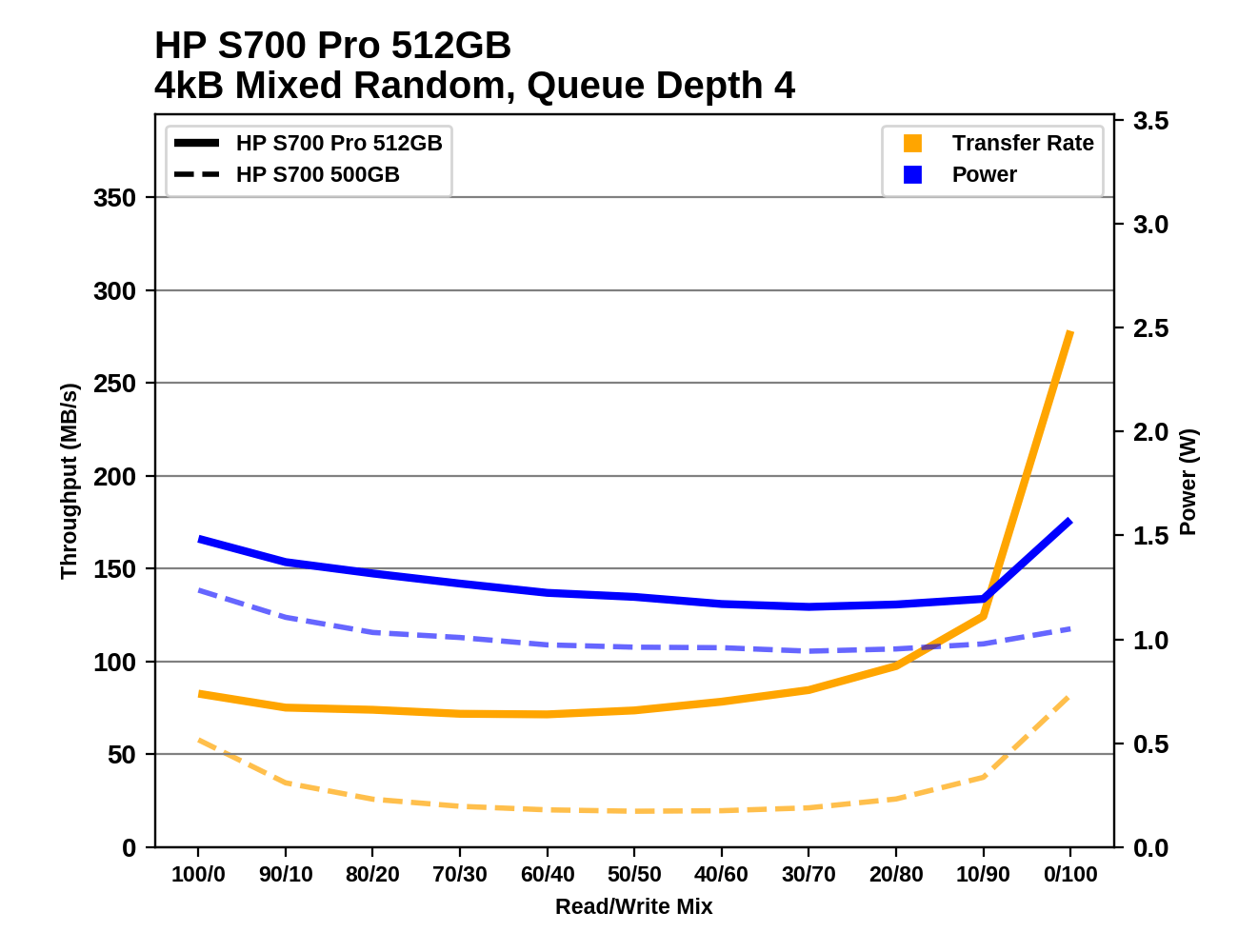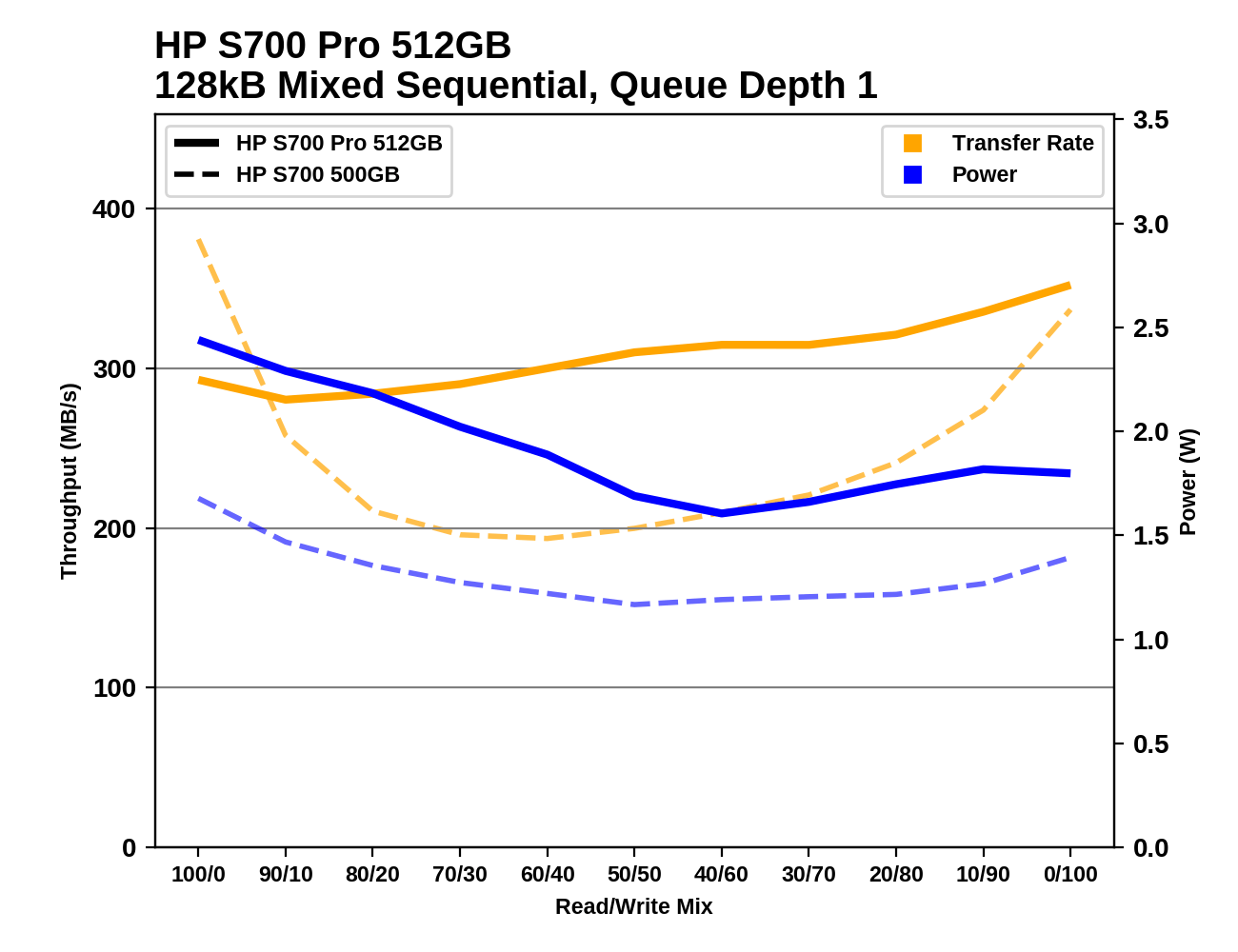The HP S700 And S700 Pro SSD Review
by Billy Tallis on September 7, 2017 9:00 AM ESTMixed Random Performance
Our test of mixed random reads and writes covers mixes varying from pure reads to pure writes at 10% increments. Each mix is tested for up to 1 minute or 32GB of data transferred. The test is conducted with a queue depth of 4, and is limited to a 64GB span of the drive. In between each mix, the drive is given idle time of up to one minute so that the overall duty cycle is 50%.

The mixed random I/O performance of the larger S700 Pros is below average, and also slower than the ADATA SU800 in specific. The S700s are the slowest of all, with the larger two offering half the performance of the slowest SSD with DRAM, and the 120GB S700 being less than half as fast as its larger siblings.

The power efficiency scores of the HP S700 aren't quite as bad as the performance scores, but it's still at the bottom of the chart and clearly worse than any SSD with DRAM. The S700 Pro is pretty efficient for a TLC-based drive, but is beat by the Crucial MX300 and Samsung 850 EVO.
 |
|||||||||
The performance of the S700 Pro only drops a little bit during the early phases of the mixed random I/O test, then rebounds gradually before spiking at the very end when every operation is a cacheable write. The 128GB S700 Pro runs out of SLC write cache space before the test is over and doesn't show the same peak in performance (though the spike in power consumption reveals the background work happening). The S700s start out slow, lose proportionally more of their performance in the early phases of the test, and only experience a small peak in performance at the end when every operation is a write.
Mixed Sequential Performance
Our test of mixed sequential reads and writes differs from the mixed random I/O test by performing 128kB sequential accesses rather than 4kB accesses at random locations, and the sequential test is conducted at queue depth 1. The range of mixes tested is the same, and the timing and limits on data transfers are also the same as above.

The mixed sequential I/O performance of the larger two HP S700 Pros is decent, and thanks to their great read speed the S700 isn't too far behind. The 120GB S700 scores significantly higher than the 128GB S700 Pro.

The power efficiency of the larger two S700s is great, but not quite up to the level of the OCZ VX500. The smallest S700 and the larger two S700 Pros are a bit above average in efficiency. The 128GB S700 Pro is near the bottom of the chart, but is more efficient than the SU800.
 |
|||||||||
The larger two S700 Pros hardly lose any performance when writes are first introduced early in the test, and gradually speed up from there. The larger two S700s show a pronounced bathtub curve for performance, but they're fast enough at either end of the test that the overall performance is decent. The smallest two HP drives suffer from unsteady and low performance as they are performing garbage collection almost from the very beginning of the test.










54 Comments
View All Comments
blahsaysblah - Thursday, September 7, 2017 - link
Anyone see the size of the S700 and think a new plug-in format for SSDs is in order. Been wishing for vertical M.2. ports since they launched. 2280 is definitely shorter than any standard video card and 2242 would be easy to engineer so it cant be snapped off easily/accidentally.Just a row of SATA M.2 cards lined up not too close to video card. Or, six M.2 ports to replace the SATA ports normally on a board. Wish cables would go away sooner.
romrunning - Friday, September 8, 2017 - link
Sure, look at the U.2 connector. More enterprise use right now, but it's on some consumer boards as well. It can connect PCIe NVMe drives.blahsaysblah - Friday, September 8, 2017 - link
Way too big. I dont understand why m.2 cant be made vertical, especially for a 2242 or 2230 sized card.Just plug in cards like DIMMs,...though i checked, they are only around 30-32mm high.
No more cables, just plug the storage directly into motherboard.
Space Jam - Thursday, September 7, 2017 - link
>While the HP S700 and S700 Pro are not currently priced competitively, they do show that there's value in continued firmware tuning. More than a year after Micron's 32-layer 3D NAND hit the market, the HP S700 sets a new record for sequential read performance from a four-channel controller, and helps show that DRAMless SSDs can't be immediately dismissed from consideration.With the pricing being what it is this SSD is laughable. For me this is kind of a deathnail for the idea of DRAMless SSDs as it's not cheaper, which is the whole reason for sacrificing DRAM and stomaching a substantial performance differential. And its DRAM posting Pro-variant manages to tango with the better drives...by being significantly more expensive with a meager warranty; albeit with fairly generous write endurance ratings...not that that matters with performance dropping like a rock on both S700 and S700 Pro as it reaches full.
The best I can say about the drive is that it isn't a HDD.
RaistlinZ - Thursday, September 7, 2017 - link
Sorry Billy Tallis, but there's no reason to buy either of these SSD's. They cost MORE and perform WORSE than drives that have been out for a few years now.StrangerGuy - Friday, September 8, 2017 - link
If could be that the only purpose of your massive failure of your product is to serve as a warning to others.lilmoe - Friday, September 8, 2017 - link
This is where i would normally complain that this is worthless and meaningless in the presence of the 850 evo. But this coming from hp might serve as a warning for ssd oems TO DROP THE DAMN PROCESS. I seriously hope that's the case, and i seriously hope other pc oems follow.As bad a this ssd looks, it would be a huge upgrade for anyone buying a laptop in the $400-600 range.
lilmoe - Friday, September 8, 2017 - link
*PRICESSanX - Friday, September 8, 2017 - link
Only high tech resellers salespeople here? In two decades I've never heard a word anyone discussed the manufacturing cost of anything at politically correct Anandtech and how rigged the component pricing is. Good example: manufacturing cost of flash was $1/GB in 2009. You will see true manufacturing cost only in the peaks of recessions. And now look at current $0.5/GB. Just factor of 2 progress in 8 years?... rotflATC9001 - Friday, September 8, 2017 - link
Can't hold a candle to the 850 Evo that's...3 years old now? And is more expensive...*Yawn* next.